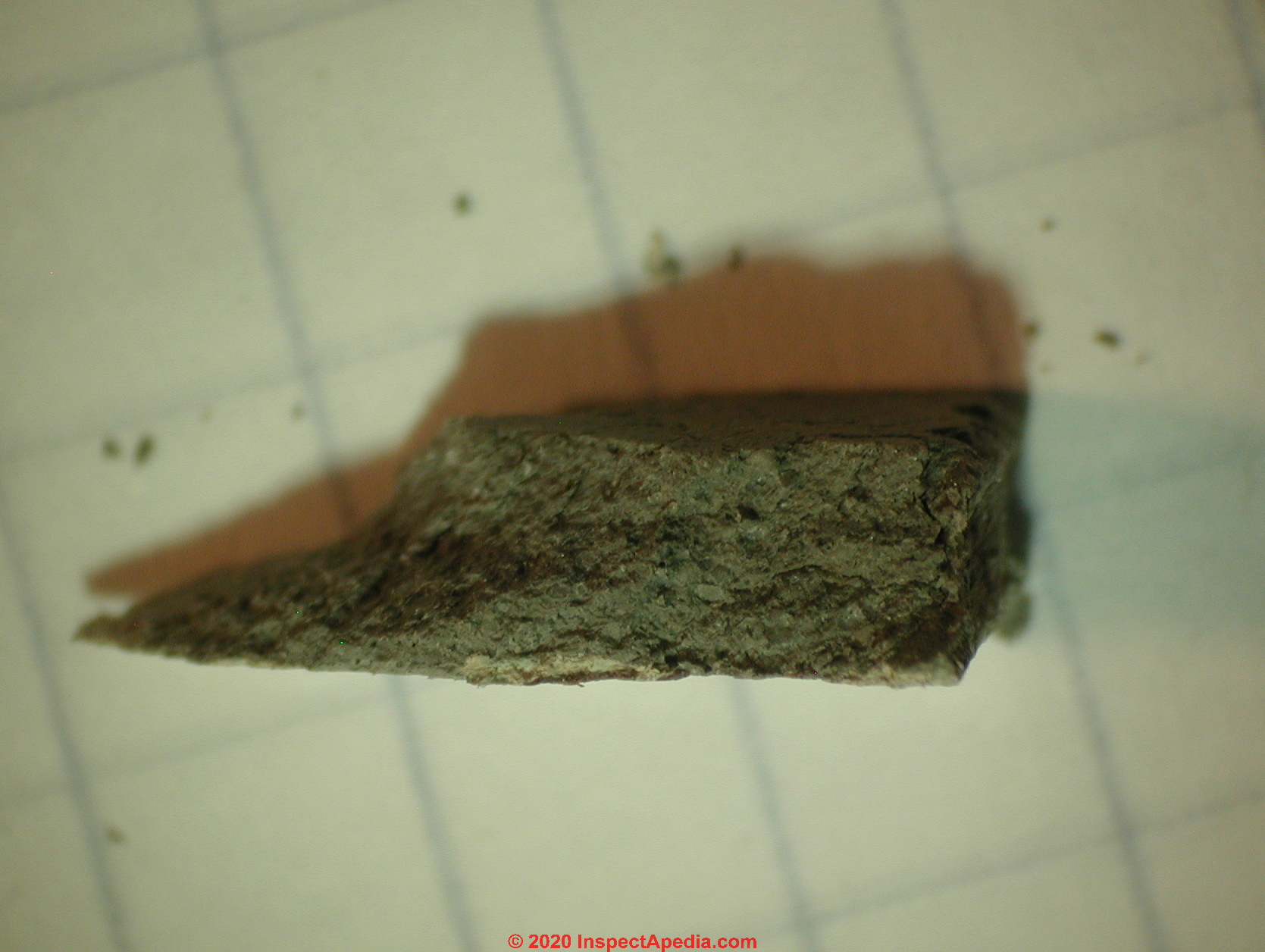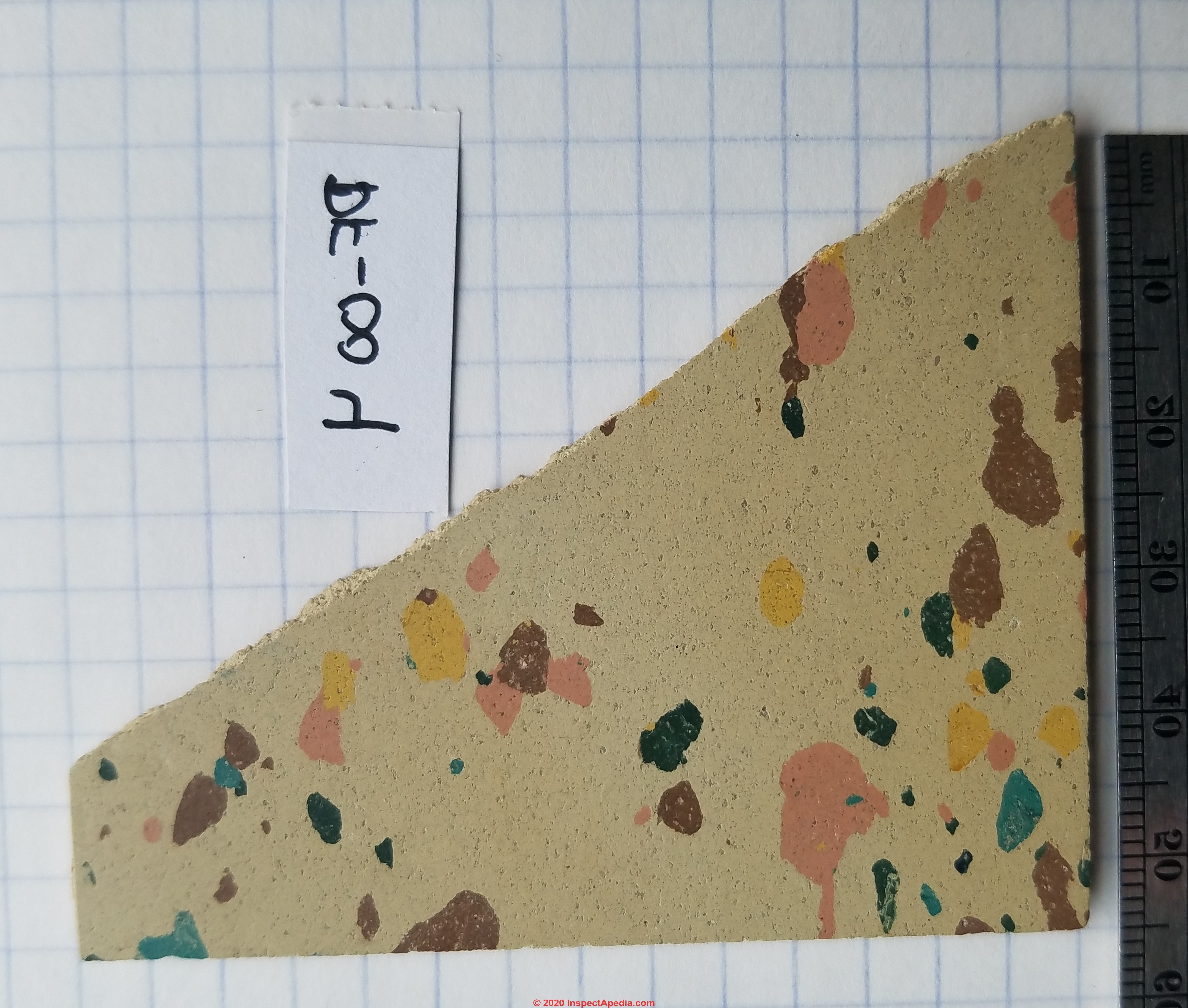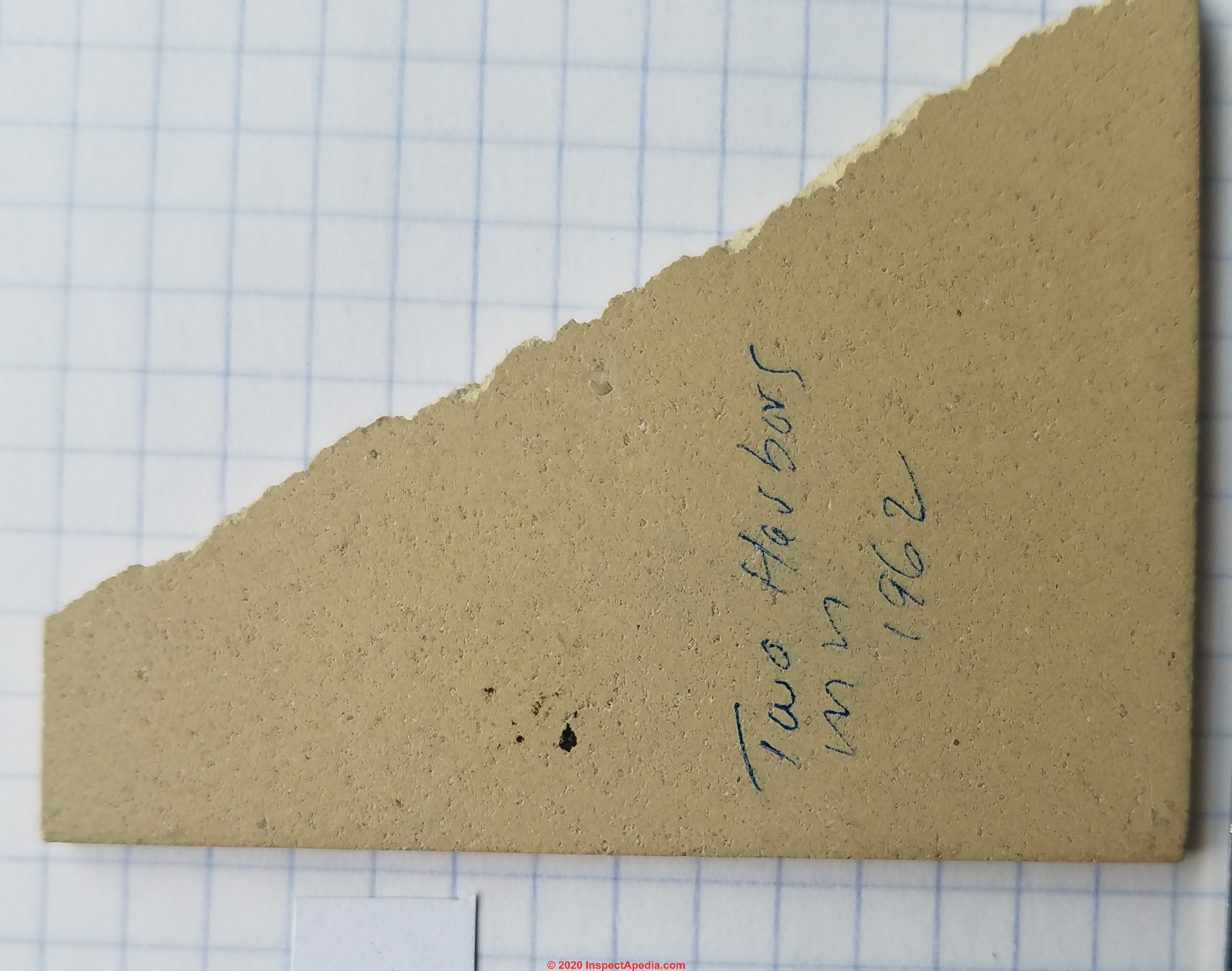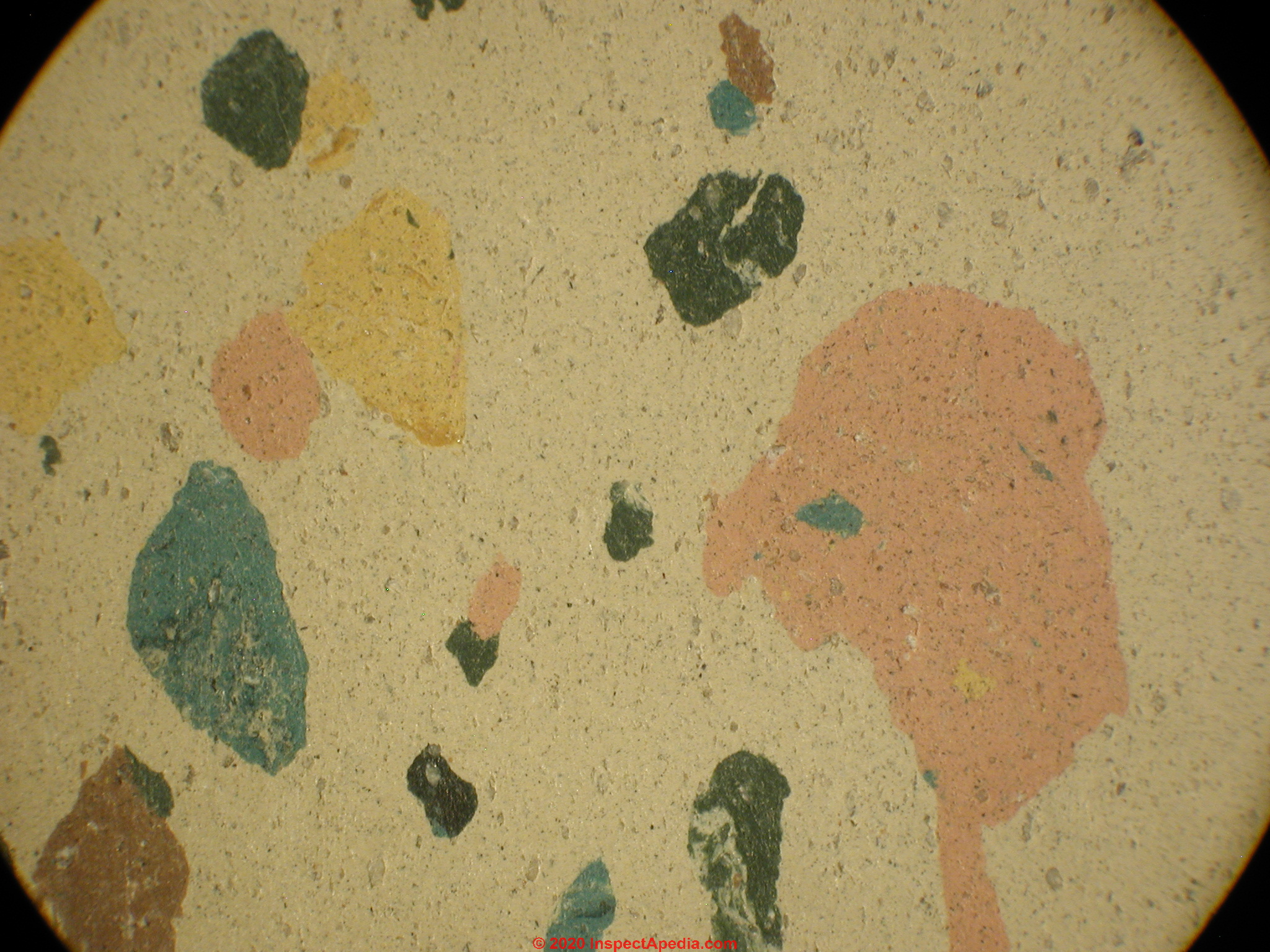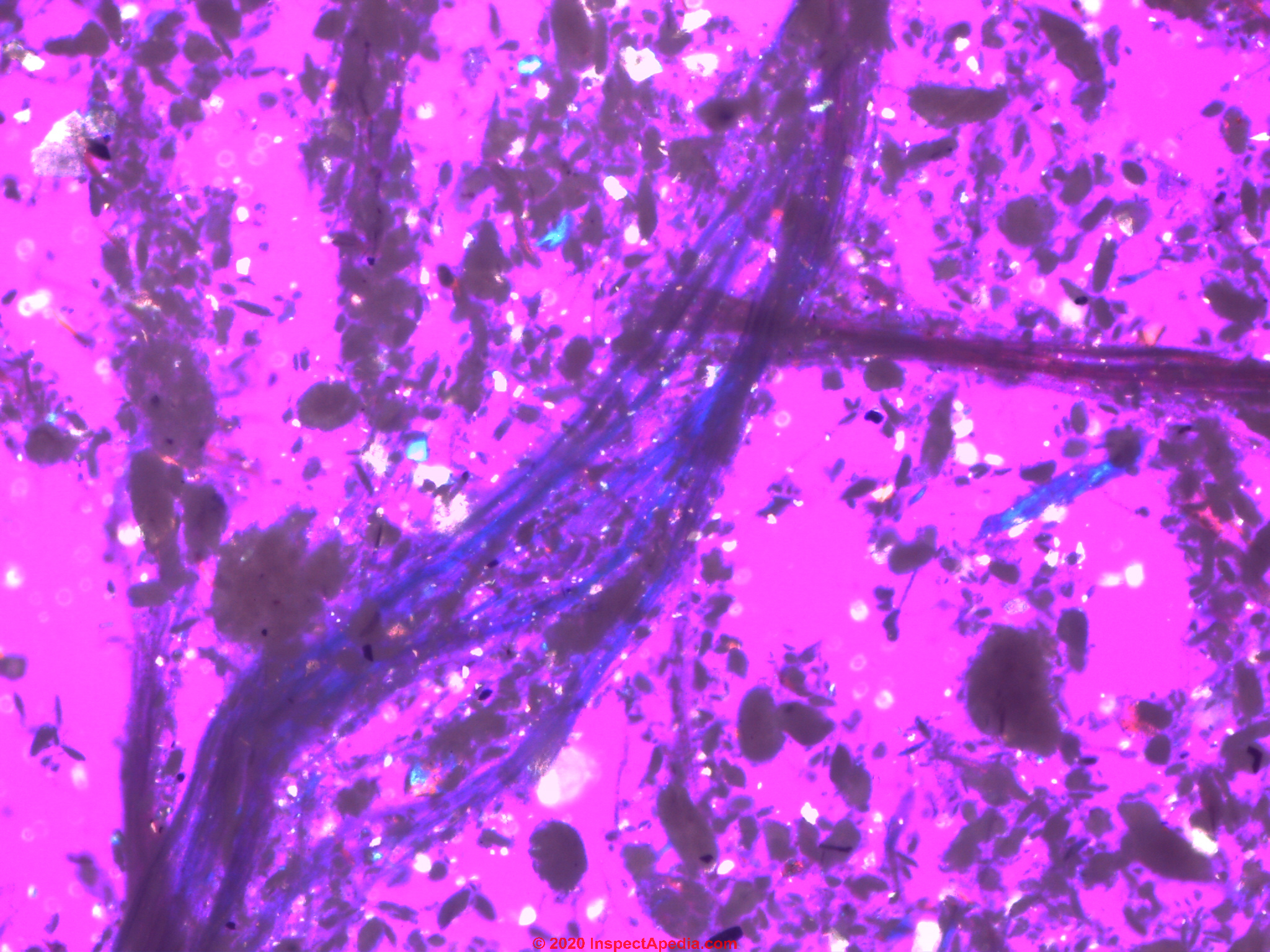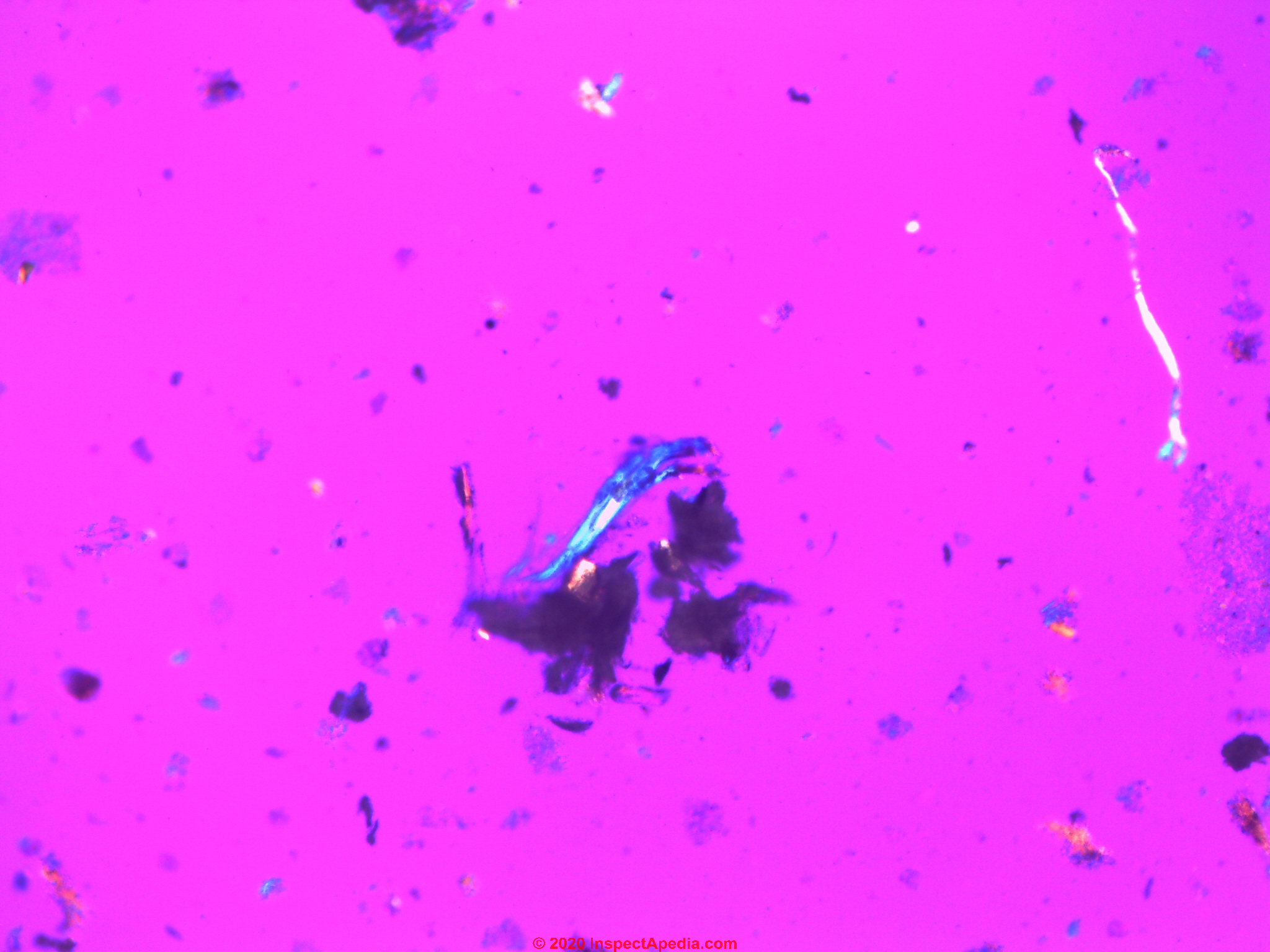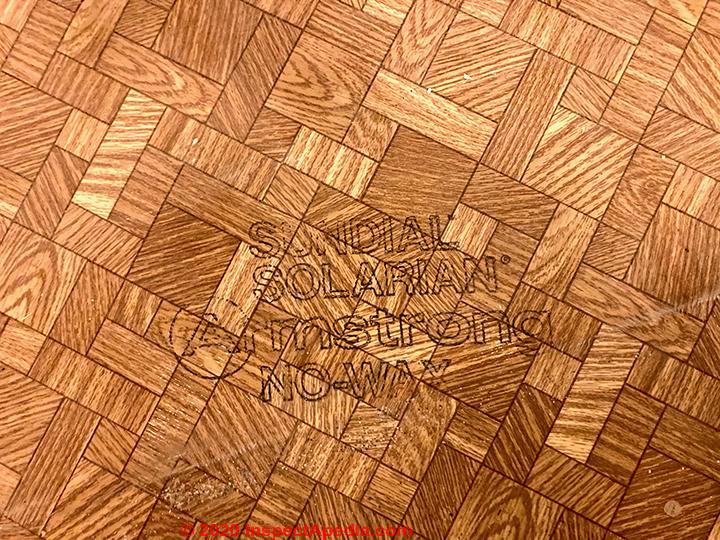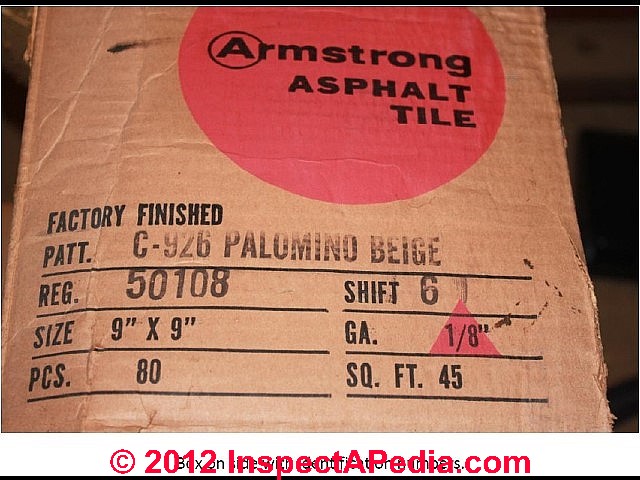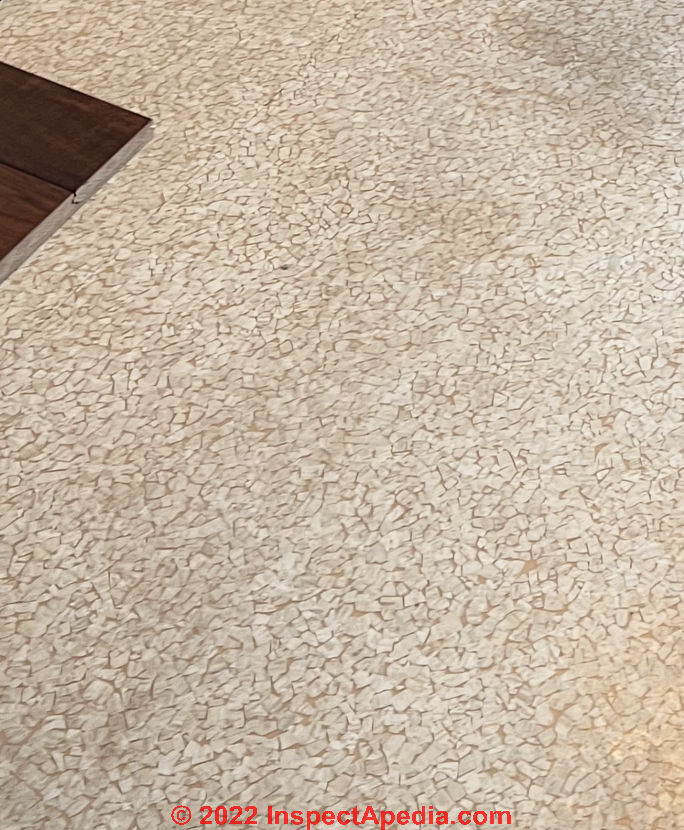 Asbestos in Armstrong Flooring
Asbestos in Armstrong Flooring
Lab Test Results for Armstrong Floor Tiles & Sheet Flooring that Contain Asbestos
- POST a QUESTION or COMMENT about tests or other documentation confirming the use of asbestos in older Armstrong flooring products
This page provides test results and photos of asbestos-containing Armstrong floor tiles & sheet flooring.
These flooring products typically contain chrysotile asbestos, and possibly other asbestos forms.
Page top photo: Armstrong Pecan Beige asphalt asbestos floor tile (pattern C-913) has been confirmed by independent testing to contain about 10% asbestos.
InspectAPedia tolerates no conflicts of interest. We have no relationship with advertisers, products, or services discussed at this website.
- Daniel Friedman, Publisher/Editor/Author - See WHO ARE WE?
Asbestos in Armstrong Asphalt & Vinyl Flooring
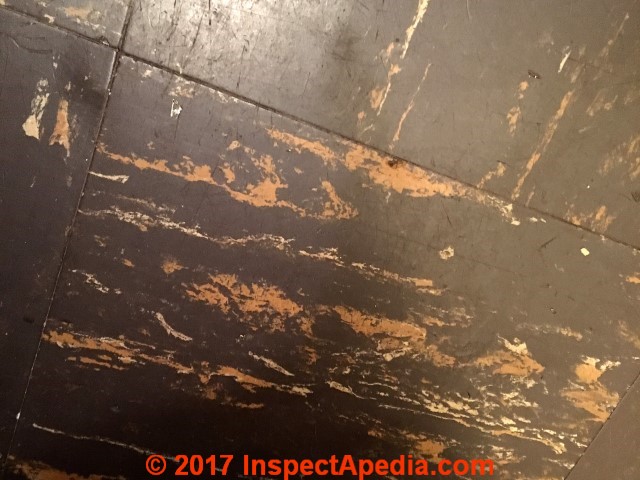
Asphalt asbestos and vinyl-asbestos floor tiles were produced in 6x6", 9" x 9", 12" x 12", and even 18" x 18" as well as in decorative strips, special cutout shapes, custom dimensions.
Photo just above: 1950's asphalt asbestos floor tile.
For a quick check and five easy questions that can help tell you if an unknown floor covering contains asbestos, try
DOES THIS FLOORING CONTAIN ASBESTOS?
Asbestos is safe and legal to remain in homes or public buildings as long as the asbestos materials are in good condition and the asbestos can not be released into the air.
Article Contents
- 1950s ARMSTRONG PLASTIC ASBESTOS FLOORING - confirmed by advertising
- 1951 - 1973 ARMSTRONG STANDARD FLOOR TILE ASBESTOS - confirmed by lab tests
- 1960-1969 VINYL FLOOR TILE ASBESTOS TESTS - 03 - flooring & lab test photos + detailed reports
- 1960-1969 VINYL FLOOR TILE ASBESTOS TESTS - 04 - 1962 Armstrrong flooring asbestos confirmed
- 1965 ARMSTRONG FLOORING ASBESTOS TEST - 06
- 1970s ARMSTRONG SHEET FLOORING 15% CHRYSOTILE ASBESTOS
- ARMSTRONG SOLARIAN 65% CHRYSOTILE ASBESTOS - Armstrong Sundial Solarian, un-dated
- DETAILED ASBESTOS TEST LAB REPORTS for ARMSTRONG FLOORING - links to downloadable PDF copies of asbestos lab results
- MARBLE CHIP PATTERN FLOORING ASBESTOS - 05 - separate article
...
Asbestos Test Results: 1960s Vinyl-Asbestos Floor Tiles
 Bottom line: Asbestos-containing sheet flooring in good condition in a residential environment is not a high risk of causing airborne asbestos hazards as the material is not friable.
Bottom line: Asbestos-containing sheet flooring in good condition in a residential environment is not a high risk of causing airborne asbestos hazards as the material is not friable.
The safest as well as least-costly course of action is to leave such flooring in place, and to cover it over with other flooring material.
Asbestos is safe and legal to remain in homes or public buildings as long as the asbestos materials are in good condition and the asbestos can not be released into the air. - US EPA
However if such flooring installed in North America before the early 1980's is in very poor condition or if it must be demolished as part of building renovations, it should be treated as presumed to contain asbestos and handled accordingly.
Flooring adhesives or mastics also may contain asbestos.
Photo above: a gray, green, and light tan asphalt-asbestos floor tile installed in a northern Minnesota home in 1962.
Using a certified asbestos testing laboratory we had this sample tested for asbestos and we report the results below.
Friable and nonfriable asbestos are defined
at ASBESTOS DEFINITION & COMPOSITION
1962 Floor Tile Sample No. 03
First, why do I call this an "asphalt-asbestos" floor tile rather than "vinyl-asbestos" or just "vinyl" floor tile? Let's look at the back of this tile.
That gray color with cracking is characteristic of an asphalt-based floor covering rather than a vinyl one.
Take a look at our next photograph below, showing the edge of this 1960's floor tile.
The edge view of this tile showing the rather homogeneous makeup of the tile except for its colored face means this is most-likely an asphalt-based tile. However, though it's reasonable to treat such flooring as presumed to contain asbestos, without an expert test one cannot be certain of the floor's asbestos content.
For example, some Armstrong 1960s floor tiles were made without asbestos in their matrix.
Above and below: additional photos of this 1960's flooring sample under our stereo-microscope,
showing the tile's face and the texture of its back or "bottom" surface.
Above: Floor Sample No. 03, a gray, tan & green floor tile installed in a Two Harbors MN home ca 1960 was tested for asbestos using Polarized Light Microscopy (PLM) by EMSL. The lab found
- Gray fibrous material, homogeneous
- 94% non-fibrous (other) Note: could in some flooring incude non-fibrous asbestos filler [Ed.]
- 6% Chrysotile asbestos
Below: an excerpt from the EMSL lab report on this flooring sample.
...
1962 Floor Tile Sample No. 04 Asbestos Detected
Both in our own InspectApedia forensic lab (Daniel Friedman, McCrone Inst. Trained forensic microscopist) and by independent test by a large national asbestos lab asbesto was cofirmed in the floor tile samples shown here.
and here is a closer look at this floor tile sample pattern under our stereo microscope.
Below: Flooring sample #04 under polarized light in a PLM microscope.
Floor Sample No. 04, a floor tile installed in a Two Harbors MN home ca 1960 was tested for asbestos using Polarized Light Microscopy (PLM) by EMSL. The lab found
- Various (colored) fibrous material, homogeneous
- 94% non-fibrous (other) Note: could in some flooring incude non-fibrous asbestos filler [Ed.]
- 6% Chrysotile asbestos
Below: an excerpt from our own EMSL lab report on this flooring sample.
...
1965 Sample Floor Tile No. 06
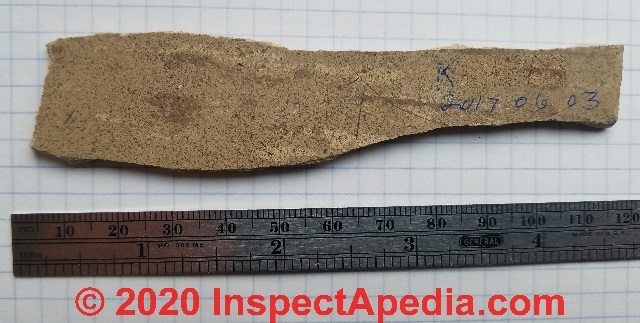
From a Poughkeepsie New York House built ca 1965, this floor tile and mastic on its back surface were sent for analysis via PLM NYS 198.6 (<1%) & TEM NYS 198.4 (<1%).
Phase 1 Examination for Asbestos: Polarized Light Microscopy (PLM)
Above: Sample 06 New York floor tile examined by PLM.
Result
- Not reported by the lab, see TEM results below.
Below: Sample 06 New York floor tile asphalt-based tile mastic adhesive, also examined by PLM.
Phase 2 Examination for Asbestos: Transmission Electron Microscope (TEM)
Above and below: photos of mastic removed from the back of our tile sample No. 6, by TEM (Transmission Electron Microscope)
The non-organically bound samples were analyzed with a transmission electron microscope (TEM) at approximately 20,000 X magnification.
Asbestos structures are identified by a combination of morphology, quantitative elemental chemistry via Energy Dispersive X-Ray Analysis (EDXA), and Selected Area Electron Diffraction (SAED).
Result:
- During TEM examination Chrysotile asbestos was detected. The total concentration was <1% (see attached report).
Really? This is a surprising result; the only rational explanations I can come up with for an asbestos level greater than zero but less than 1% might be that the lab is not going to risk guaranteeing zero asbestos in the sample if that's a level of asbestos below that that their procedure can detect, OR the flooring has slight asbestos in its matrix from cross-contamination.
Also we don't know if the lab is looking only for characteristic and comparatively large asbestos fibers or if the procedure also detects shorts or fines of asbestos widely used as filler in asphalt-asbestos and vinyl-asbestos floor tile.
To be clear, there were some 1960's asphalt- or vinyl-based floor tiles that did NOT contain asbestos.
...
Asbestos Test Lab Reports for Armstrong Floor Tile & Sheet Floor Samples
- ASBESTOS TEST RESULTS SUMMARY [PDF] 2020/01-18-20, Test Report: Asbestos Analysis of Bulk Materials via EPA 600/R-93/116 Method using Polarized Light Microscopy EMSL Ord No. 042000629 2019-12-26 for samples No. 001-005 and 008-015.
For samples 001-005, and 008-014
Sample No. 03: see details at 1960-1969 VINYL FLOOR TILE ASBESTOS TESTS - 03 - 1962 Asphalt asbestos floor tile
Sample No. 04: see details at 1960-1969 VINYL FLOOR TILE ASBESTOS TESTS - 04 - 1962 Asphalt asbestos floor tile
Sample No. 05: see details at MARBLE / STONE CHIP PATTERN FLOORING ASBESTOS - sheet flooring
- ASBESTOS TEST REPORT: Asbestos analysis of ca 1965 FLOOR TILE from a NEW YORK HOME [PDF] 2020/01/23 Test Report (PLM NYS 198.6 NOB and TEM NYS 198.4 NOB)
Sample No. 06: see details at 1960-1969 ASPHALT FLOOR TILE ASBESTOS TEST - 06 - ca 1965 Asphalt based floor tile using special methods required by NY State
- Also see asphalt and vinyl asbestos-suspect flooring test results at
NAFCO VINYL FLOOR TILES IDENTFICATION
- Contact: EMSL Analytical, Inc., 200 Route 130 North, Cinnaminson, NJ 08077 USA, Tel: 856-303-2500 - Fax: 856-786-5974 - Toll Free: 800-220-3675
Lab Hours: Mon-Friday 7AM-10PM, Saturday 8AM-5PM, Sunday On-Call. - ASBESTOS TEST LABS in the USA - EXAMPLE REPORTS - provides fourteen example asbestos test results from EMSL
...
Asbestos Test Results: Armstrong Solarian 65% Chrysotile Asbestos Content
We tested this Armstrong Sundial Solarian sheet flooring for asbestos
We tested this Armstrong Sundial Solarian sheet flooring.
The test results show the backing made of is 65% chrysotile asbestos fiber.
The area in the image was under a cabinet and still had the Armstrong stamp on it. In another area, it looks like it might be numbered 66660. - 2020/12/09 ED said:
Moderator reply:
Ed, thank you very much for posting the photo and asbestos test results for that Armstrong Solarian flooring. That information will be most helpful to other readers.
Do you have an idea of the age of the building in which the floor was installed and perhaps about when the flooring itself was placed?
Country and city are also helpful.
More lab test results for asbestos in Armstrong flooring are
at ARMSTRONG SOLARIAN NO-WAX FLOORING HISTORY - and asbestos use<
...
Test Results for Armstrong Sheet Flooring - 0% to 40% to 70% Chrsotile Asbestos
The resilient flooring shown above was a popular pattern and in three out of four tests reported by our readers has been confirmed as containing asbestos.
Watch out: as we explain in detail at SHEET & TILE FLOORING ASBESTOS ID-BRICK PATTERN ID, the varied-square-sized flooring like the Armstrong pattern shown here (probably Armsrtrong #5352 "Linoleum") has been found to contain asbestos - 40% chrysotile asbestos - OR - no asbestos - depending on when it was made and which backing material was used.
More images and information about of this floor pattern as well as flooring in larger or "full brick" size patterns are on that page
and also at ARMSTRONG BRADFORD BRICK SHEET
...
Test Results for 1970s Armstrong Sheet Flooring - 15% Chrysotile Asbestos
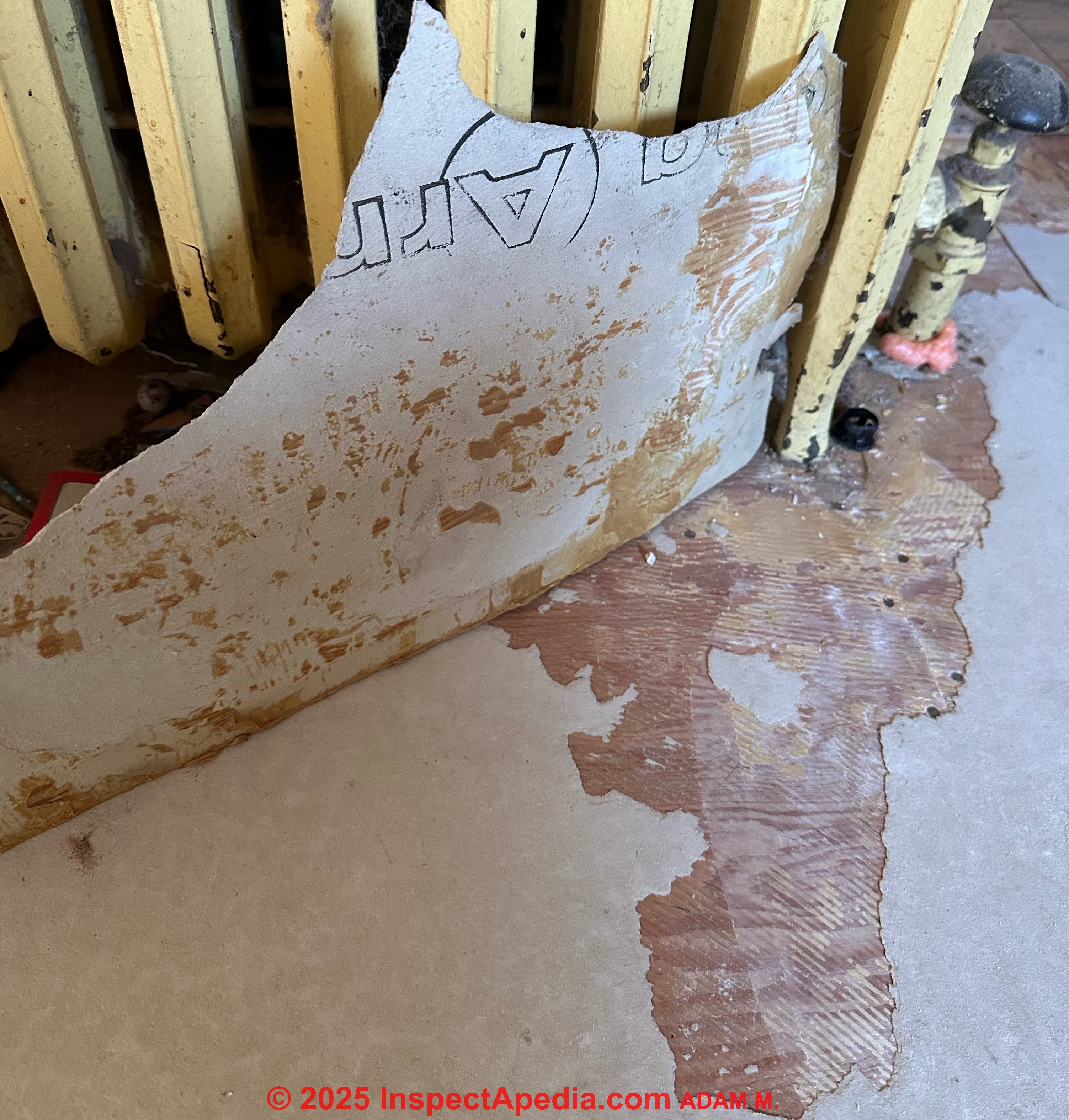
In the flooring photo above and asbestos lab test report below, another inspectApedia reader reported on their test for asbestos in Armstrong sheet flooring found in a home dating from 1932 and located in upstate New York near Troy.
The sheet flooring was definitely from a later renovation, probably from the 1960s or 1970s.
Huge fan of the InspectApedia and have learned so much from it. I thought I’d try to help to return the favor. Had a few older materials tested as I’m undergoing a Reno project.
I tested sheet vinyl flooring backing, best wall plasterboard and then the compound used (I think I have rock lath with compound squeezed in).Results attached! Only the floor came back positive. - private email to editor Nov 21, 2024
The report below found15% Chrysotile asbestos in a flooring sample #678A submitted by this reader to SEEML Labs in November 2024.
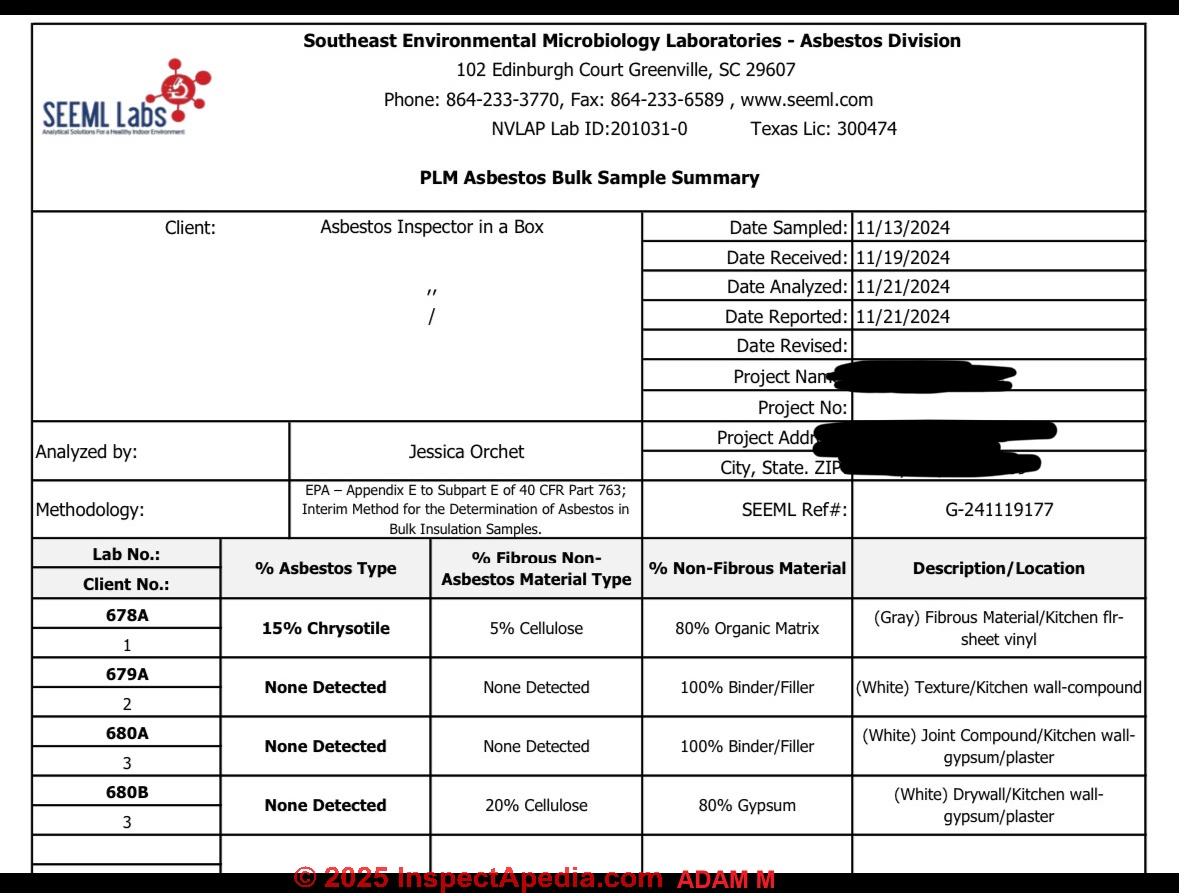
...
Test Results for Armstrong Shattered Stone Sheet Flooring - 70% Asbestos confirmed
Reader comment:
In one of the asbestos pages of your site ( this page - Ed.), your second photo is of a sheet layment. The text about the photo clarifies that the person who sent the photo was confused about Armstrong and Congoleum.
I wanted to let you know that I have that exact same sheet layment and had it tested. It's 70% asbestos.
Thought you may want to let readers know so they can save the cost of testing and just deal with the issue accordingly.
I appreciate your site. Thank you for taking the time to put together all the information. - D.H. 10/11/2012
Reply:
Thank you so much D.H. for the floor confirming the test result for asbestos content in this flooring material.Also see OLD PEBBLE PATTERN FLOOR TILE for discussion of a similar product image.
Watch out: confusion among sheet flooring names and terms can make it difficult to sort out which products contain asbestos.
For example we've read websites claiming that "in 1980 asbestos in linoleum was already banned" but in fact true linoleum, a type of sheet flooring discussed
at LINOLEUM & SHEET FLOORING is not and never was an asbestos-containing product.
The confusion stems from the use of the word "linoleum" as a generic term for "sheet flooring". Linoleum does not contain asbestos.
But many sheet flooring products do contain asbestos in a white or light colored core or in a black asphalt-impregnated felt backer.
Some readers have reported that their test of 1980-era Armstrong Solarian sheet flooring contained asbestos. Without confirming that the floor was properly identified and without seeing the lab report such reports may be true and accurate but still they're anecdotal.
...
Asbestos in Standard Armstrong Floor Tiles Confirmed
According to Armstrong vinyl-asbestos floor tiles such as those shown here were produced by the company from 1951 through 1973.
These examples illustrate two shades of Palimino Beige 9"x9"x1/8"-thick asphalt-asbestos tile (AAT) whose asbestos content has been confirmed by asbestos test lab results generously provided along with these photographs by reader L.R. (October 2012).[25]
Our own field work has found that this tile pattern, in a range of colors illustrated below, was enormously popular and can still be found installed in thousands of homes built between 1951 and the early 1970's.
The most common colors we have found include the beige shades shown below along with green, white, black, and Apache red illustrated further below.
The Armstrong Pecan Beige asphalt asbestos floor tile illustrated at above left (pattern C-913) has been confirmed by independent testing to contain about 10% asbestos while the Armstrong Palimino Beige asphalt floor tile (above right, pattern C-926) was confirmed at 6.4% asbestos.
Our photo, courtesy of reader L.N. illustrates the original packaging used for Armstrong asphalt floor tiles - Armstrong Asphalt Floor Tile, produced by Armstrong’s Cork division.
The tile pattern identified as C-926 Palimon Beige corresponds to the tile photograph at above right, a 1/8" gauge asphalt asbestos floor tile.
These tiles are mostly asphalt with the percentages of asbestos given above, as tested by the reader's asbestos lab. Armstrong has indicated that that these tiles almost certainly contained asbestos but they said that as long as the tiles are not ground or sanded there should not be a detectable asbestos hazard in residential use.
...
1950's Armstrong Excelon Plastic Asbestos Floor Tiles Described as "plastic asbestos tiles".
Definition & Composition of Vinyl based asbestos resilient floor tiles
Vinyl asbestos floor tiles (VAT) refers to resilient flooring whose basic binding material was a vinyl plastic, replacing asphalt as the primary ingredient.
The 1954 catalog refers to the existence of at least a 1952 version of this vinyl-asbestos resilient floor tile product:
"Federal Specifications - Interim Federal Specifications No. L T 751 (GSA-FSS) dated March 18, 1952, defines Armstrong's Excelon Tile and other similar plastic asbestos tiles as Type I Semi Flexible Vinyl Plastic Floor Tile.
...
... the thermoplastic binder of a vinyl plastic floor tile shall consist of only a limited group of certain specific types of polyvinyl chloride resins despite the fact that a wide range of vinyl resins could be used.
...
... note that while Excelon Tile does not the exact material composition of Interim Specifications No. L T 751, it does meet all the physical tests listed."
...
Reader Comments, Questions & Answers About The Article Above
Below you will find questions and answers previously posted on this page at its page bottom reader comment box.
Reader Q&A - also see RECOMMENDED ARTICLES & FAQs
These readers' tests confirmed asbestos in certain Armstrong flooring products.
9% Chrysotile asbestos confirmed in this Armstrong marble chip pattern vinyl flooring
This Armstrong vinyl flooring has 9% asbestos chrysotile - On 2022-03-23 by Sue Woznuk -
Reply by Inspectapedia Com Moderator (mod) - this Armstrong vinyl flooring has 9% asbestos chrysotile
@Sue Woznuk,
Thank you for that asbestos test report - it will certainly help other readers, and we'll keep it with this page.
Can you tell us the country and city of location of the building where this floor is installed, and tell us the building age and, if you know it, the age of the flooring?
You can if you're willing, use the page top or bottom CONTACT link to let me see a copy of the lab report - (we keep your identity and personal information private).
Thanks.
Reader Comments or Questions on Solarian Floor Tile History & Asbestos Content
 65% Chrysotile asbestos confirmed in Armstrong Solarian Sundial # 66660 sheet flooring
65% Chrysotile asbestos confirmed in Armstrong Solarian Sundial # 66660 sheet flooring
We tested this Armstrong Sundial Solarian sheet flooring. The test results show the backing made of is 65% chrysotile asbestos fiber.
The area in the image was under a cabinet and still had the Armstrong stamp on it.
In another area, it looks like it might be numbered 66660. - On 2020-12-09 by ED
Reply by (mod) -
Ed, thank you very much for posting the photo and asbestos test results for that Armstrong Solarian flooring.
That information will be most helpful to other readers.
Do you have an idea of the age of the building in which the floor was installed and perhaps about when the flooring itself was placed?
Country and city are also helpful.
Do you think this late 1960's pebble-pattern floor tile contains asbestos?
QA moved to 1960-1969 ARMSTRONG EXCELON FLOOR TILE GUIDE - PEBBLE PATTERN FLOOR TILE
...
Continue reading at ASBESTOS FLOOR IDENTIFICATION - home or select a topic from the closely-related articles below, or see the complete ARTICLE INDEX.
Or see these
Recommended Articles
- ASBESTOS FLOOR TILE PHOTO ID GUIDE - home
- ASBESTOS FLOORING HAZARD REDUCTION - recommendations useful for leaving this flooring in place, or
- ASBESTOS FLOORING IDENTIFICATION GUIDE INDEX - all brands, all years
- ASBESTOS FLOORING REMOVAL GUIDE
- ASBESTOS RISK ASSESSMENT
- ASBESTOS TEST LAB REPORTS
- ASBESTOS TEST RESULTS for TILE & SHEET FLOORING
- ASBESTOS TESTING LAB LIST
- ASBESTOS TESTING SAMPLE COLLECTION
- DOES THIS FLOOR CONTAIN ASBESTOS? - 5 easy questions to tell if your FLOOR probably contains asbestos -
- FLOOR COVERINGS: 1900 - 1949
- MARBLE / STONE CHIP PATTERN FLOORING ASBESTOS
- MASTIC, CUTBACK ADHESIVE, FLASHING CEMENT ASBESTOS
Suggested citation for this web page
ASBESTOS TEST RESULTS for TILE & SHEET FLOORING - at InspectApedia.com - online encyclopedia of building & environmental inspection, testing, diagnosis, repair, & problem prevention advice.
Or see this
INDEX to RELATED ARTICLES: ARTICLE INDEX to ASBESTOS HAZARDS
Or use the SEARCH BOX found below to Ask a Question or Search InspectApedia
Ask a Question or Search InspectApedia
Try the search box just below, or if you prefer, post a question or comment in the Comments box below and we will respond promptly.
Search the InspectApedia website
Note: appearance of your Comment below may be delayed: if your comment contains an image, photograph, web link, or text that looks to the software as if it might be a web link, your posting will appear after it has been approved by a moderator. Apologies for the delay.
Only one image can be added per comment but you can post as many comments, and therefore images, as you like.
You will not receive a notification when a response to your question has been posted.
Please bookmark this page to make it easy for you to check back for our response.
IF above you see "Comment Form is loading comments..." then COMMENT BOX - countable.ca / bawkbox.com IS NOT WORKING.
In any case you are welcome to send an email directly to us at InspectApedia.com at editor@inspectApedia.com
We'll reply to you directly. Please help us help you by noting, in your email, the URL of the InspectApedia page where you wanted to comment.
Citations & References
In addition to any citations in the article above, a full list is available on request.
- [1] Armstrong ® Residential Flooring - Website 05/15/2010 https://www.armstrongflooring.com/ lists current flooring products provided by the Armstrong Corporation, including Armstrong's current vinyl floor tile products at https://www.armstrongflooring.com/flooring/products/vinyl-floors
- [2] Armstrong Corporation, Corporate History - https://www.armstrongflooring.com/corporate/corporate-history.html - Web Search 05/19/2010
- [3] Armstrong vinyl asbestos floor tiles: photos of asbestos-vinyl floor tiles as catalog pages (PDF form) are at www.asbestosresource.com/asbestos/tile.html
- ASBESTOS TEST REPORT: Asbestos analysis of ca 1965 FLOOR TILE from a NEW YORK HOME [PDF] 2020/01/23 Test Report (PLM NYS 198.6 NOB and TEM NYS
- ASBESTOS TEST REPORT: Asbestos Analysis of Non-Friable Organically Bound Materials by TEM via EPA/600/R-93/116 Section 2.5.5.1 [PDF] 2020/01/22 Test Report: Asbestos Analysis of Non-Friable Organically Bound Materials by TEM via EPA/600/R-93/116 Section 2.5.5.1
- [5] "Asbestos in your home or at work," Forsyth County Environmental Affairs Department, Winston-Salem NC 12/08
- [6] "Asbestos Floor Tile Removal", the University of Minnesota's advice on removing VAT (vinyl asbestos or asphalt asbestos floor tile) can be read in detail at www.health.state.mn.us/divs/eh/asbestos/floortile/index.html
- [7] Copy on file as ASBESTOS IN YOUR HOME - U.S. EPA, Exposure Evaluation Division, Office of Toxic Substances, Office of Pesticides and Toxic Substances, U.S. Environmental Protection Agency, Washington,D.C. 20460
- [8] Resilient Floor Covering Institute, 1030 15th St. NW, suite 350, Washington D.C.
- [9] Inspiring Interiors from Armstrong 1950s from Armstrong, [Paperback], Schiffer Publishing (March 1998), ISBN-10: 0764304585, ISBN-13: 978-0764304583
- [1] Interior Solutions from Armstrong the 1960s from Armstrong, [Paperback], Schiffer Publishing (March 1999), ISBN-10: 0764307002, ISBN-13: 978-0764307003
- [10] Mechanix Illustrated How-to-do-it Encyclopedia Vol 2. -1961
- [11] Asbestos products and their history and use in various building materials such as asphalt and vinyl flooring includes discussion which draws on ASBESTOS, ITS INDUSTRIAL APPLICATIONS, ROSATO 1959, D.V. Rosato, engineering consultant, Newton, MA, Reinhold Publishing, 1959 Library of Congress Catalog Card No.: 59-12535 (out of print).
- [12] Congoleum Corporation, "Company History", Congoleum Corporation, Department C, P.O. Box 3127, Mercerville, NJ 08619-0127 1-609-584-3601, web-search 03/14/2011, original source: http://www.congoleum.com/history.html
- [13] David Grudzinski, Advantage Home Inspections, is a professional home inspector in Cranston, RI. 02910. He can be reached at 401-935-6547, fax- 401-490-0607 or by email to contact/us@advantagehomeinspections.us 04/26/2009
- [14] EPA Guidance for Controlling Asbestos-Containing Materials in buildings, NIAST, National Institute on Abatement Sciences & Technology, [republishing EPA public documents] 1985 ed., Exposure Evaluation Division, Office of Toxic Substances, Office of Pesticides and Toxic Substances, U.S. Environmental Protection Agency, Washington,D.C. 20460
- [15] EPA ASBESTOS MATERIALS BAN: CLARIFICATION 1999
- [16] EVER WEAR TILE CO is currently (2009) in the Terrazzo, Tile, Marble, and Mosaic Work industry in Fallon, NV. 775) 423-6221. [We do not know the company history nor whether there is an association with EverWear vinyl asbestos floor tiles discussed in this article.]
- [17] Kentile KenFlex flooring photographs:Flickr web search 5/15/2010 - see original material and other asbestos product photos
- [18] "Plastic Flooring Spreads Through the House", Jackson Hand, Guide to Home-Improvement Materials, Popular Science, April 1969, p. 154-158
- [19] Thomas Hauswirth, Managing Member of Beacon Fine Home Inspections, LLC and (in 2007) Vice President, Connecticut Association of Home Inspectors Ph. 860-526-3355 Fax 860-526-2942 beaconinspections@sbcglobal.net 06/07: thanks for photographs of transite asbestos heating ducts
- [20] Gary Randolph, Ounce of Prevention Home Inspection, LLC Buffalo, NY, for attentive reading and editing suggestions. Mr. Randolph can be reached in Buffalo, NY, at (716) 636-3865 or email: gary@ouncehome.com 3/07
- [21] Thanks to reader Matt Abel, Design Services Department, Strongwood Log Home Company, 711 Shadow Road, Waupaca WI 54981, Office (715) 258-4818, Toll Free (866) 258-4818, www.gostrongwood.com "Begin your journey home.." for vinyl asbestos floor photos, October 2010.
- [22] Thanks to reader Meryl Silvers for hexagonal floor tile photos showing a possilbe Kentile product that contained asbestos. October 2010.
- [23] Thanks to reader N.H. for providing a photo of 1970's era vinyl asbestos floor tile that we identify as most likely Armstrong Solarian Devonport white.
- [24] M.B. provided photographs of Congoleum linoleum flooring from a 1960's Tampa Florida home.
- [25] L.R. provided photographs of Armstrong Palimino Beige and Pecan Beige asphalt asbestos floor tiles, floor tile packaging and identification details, along with asbestos test lab results. Personal correspondence with DF, 10/22/2012
- Asbestos Identification and Testing References
- [27] Asbestos Identification, Walter C.McCrone, McCrone Research Institute, Chicago, IL.1987 ISBN 0-904962-11-3. Dr. McCrone literally "wrote the book" on asbestos identification procedures which formed the basis for current work by asbestos identification laboratories.
- [28] Stanton, .F., et al., National Bureau of Standards Special Publication 506: 143-151
- [20] Pott, F., Staub-Reinhalf Luft 38, 486-490 (1978) cited by McCrone
- [30] ASBESTOS IN YOUR HOME U.S. EPA, Exposure Evaluation Division, Office of Toxic Substances, Office of Pesticides and Toxic Substances, U.S. Environmental Protection Agency, Washington,D.C. 20460
- Asbestos products and their history and use in various building materials such as asphalt and vinyl flooring includes discussion which draws on ASBESTOS, ITS INDUSTRIAL APPLICATIONS, ROSATO 1959, D.V. Rosato, engineering consultant, Newton, MA, Reinhold Publishing, 1959 Library of Congress Catalog Card No.: 59-12535 (out of print, text and images available at InspectAPedia.com).
- [31] "Handling Asbestos-Containing roofing material - an update", Carl Good, NRCA Associate Executive Director, Professional Roofing, February 1992, p. 38-43
- [32] EPA Guidance for Controlling Asbestos-Containing Materials in buildings, NIAST, National Institute on Abatement Sciences & Technology, [republishing EPA public documents] 1985 ed., Exposure Evaluation Division, Office of Toxic Substances, Office of Pesticides and Toxic Substances, U.S. Environmental Protection Agency, Washington,D.C. 20460
- In addition to citations & references found in this article, see the research citations given at the end of the related articles found at our suggested
CONTINUE READING or RECOMMENDED ARTICLES.
- Carson, Dunlop & Associates Ltd., 120 Carlton Street Suite 407, Toronto ON M5A 4K2. Tel: (416) 964-9415 1-800-268-7070 Email: info@carsondunlop.com. Alan Carson is a past president of ASHI, the American Society of Home Inspectors.
Thanks to Alan Carson and Bob Dunlop, for permission for InspectAPedia to use text excerpts from The HOME REFERENCE BOOK - the Encyclopedia of Homes and to use illustrations from The ILLUSTRATED HOME .
Carson Dunlop Associates provides extensive home inspection education and report writing material. In gratitude we provide links to tsome Carson Dunlop Associates products and services.



